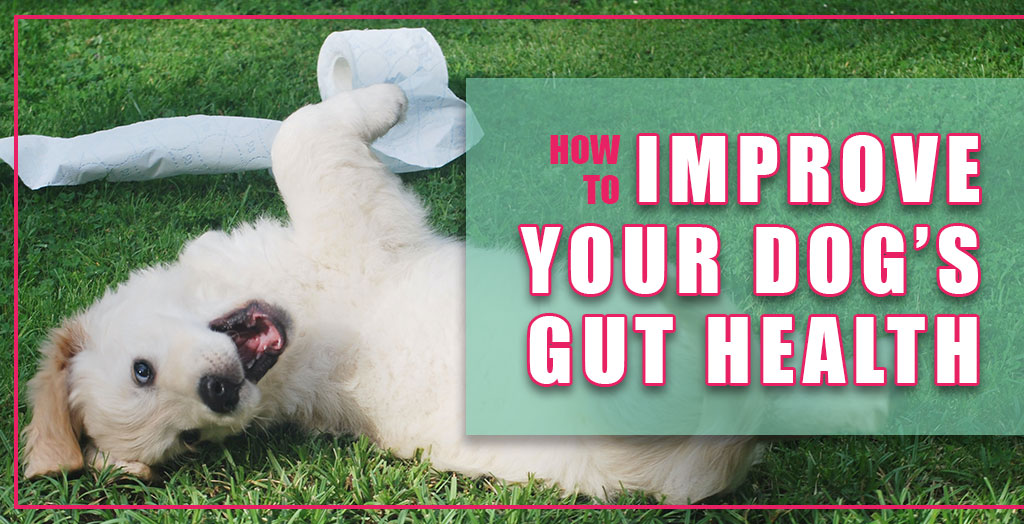Gut health is the foundation for everything. Good dog gut health aids in optimal digestion, reduces inflammation, boosts immune function, creates a balanced microbiome and so much more. Contrary, poor dog gut health often exacerbates common conditions such as diarrhea, allergies and other diseases. In this article, I want to teach you my holistic approach to improving dog gut health and digestion in dogs. These tips are simple and can be implemented at home, right now!
You may be wondering whether or not your dog has good (or bad) digestion. While some symptoms, such as the quality of your dog’s poop, can be really obvious, there are also subtle signs that can cue you into the status of your dog’s gut heath.
Signs that your dog may be experiencing poor gut health include:
- Bad breath
- Poor quality of coat
- Itchy or other skin issues
- Vomit, diarrhea or constipation
- Appetite changes
Unfortunately, the above symptoms can be signs of other diseases and conditions, so it is important to stay in communication with your pup’s veterinarian to determine if other diagnostics or considerations should be made.
Below are FOUR tips for improving your dog’s gut health today:
Upgrade your dog’s food.
Food is medicine. While I am a big proponent of pharmaceutical interventions when needed, a quality diet is the cornerstone to health. Nothing really compares!
To improve dog gut health I will always recommend the least processed option when feeding your dog. This means ideally feeding a canned, home-cooked or raw food diet. I understand that this can get tricky if you are feeding large or multi-dog households, or if you’re on a tight budget. For these situations, consider a meal rotation (for example, one raw or soft food meal a day or every other day). Another budget conscious option for optimizing your pup’s diet would be adding in whole foods.
Whole foods that your dog can eat include:
- Egg
- Sweet potato
- Carrots
- Shredded chicken
- Apple
- Berries
- Leafy greens
Always be sure to avoid xylitol (artificial sweetener sometimes found in peanut butter), chocolate, raisins/grapes, onions or macadamia nuts.
I offer more tips around saving money while feeding your dog a healthy diet here.
Identify food allergies.
Warning: This can become a giant rabbit hole!
My heart goes out to all of my patients with food allergies, and to their people. Identifying food allergies is often a very time-intensive and frustrating process. I know this to be true personally when caring for my own allergic pup, and from counseling thousands of pet parents through their experiences.
Food allergies not only affect your dog’s skin and coat, but also impact dog gut health. There are many ways to begin the process of identifying food allergies, and whether your pup has mild or severe allergies will likely dictate the direction you take.
A few approaches to identifying food allergies in your pup may include:
- Try a novel protein. These diets include proteins that are less commonly used in the pet food industry, making previous exposure to this protein less likely. Examples of novel proteins include kangaroo, catfish, rabbit, or venison.
- Try an amino acid diet. An amino acid based diet is a diet where the protein is broken down so much that the body cannot recognize or react to it. These diets are prescription diets and not at all natural. While I know that can feel like a deterrent, these diets can be incredibly beneficial as a diagnostic tool and for a gut reset. For example, I will often suggest a 4-6 week trial on this diet for allergic dogs. If this diet provides relief, I will recommend using it for 14 weeks. This gives the gut time to heal and possibly resolve the current food allergies. From there, I suggest adding one single ingredient back into the diet at a time. You can read my full approach for using an amino acid diet for your dog here.
- Limited ingredient diet. These diets usually include one protein source and one or two carbohydrate and fat sources. These can be purchased or home made. They can be helpful at identifying food allergies if the allergen is not part of the formula.
Add a quality probiotic.

Probiotics play an important role in balancing out your dog’s gut flora, aka bacteria. A balanced microbiome (helpful and harmful microorganisms in your dog’s digestive tract) will play a key role in optimal dog gut health.
My favorite probiotics for dogs include:
- Thorne Bacillus Coagulans (soil based)
- RxBiotics (non-soil based)
- Fermented blueberries (recipe here)
I always recommend rotating out probiotics, so that you are continuing to introduce new strains to your dog.
Be smart with antibiotics.
Antibiotics can be a critical part of your dog’s treatment plan. It’s also true that they can wreak havoc on dog gut health. Even worse, inappropriate use can cause antibiotic resistance (this truly terrifies me). Your dog may very likely require antibiotics at some point in their life. If you’re already feeding a quality diet, avoiding allergens and incorporating probiotics, you’ve already done a lot of the work to ensure your pup’s gut is in a good spot for weathering antibiotics.
However, here are a few additional ways that you can be smart when using antibiotics for your pup:
- Culture. If an infection of the skin or bladder (or anything really) isn’t going away, this is a really important step to guide treatment protocol. Prolonged use of antibiotics, especially the wrong ones, can cause antibiotic resistance in bacteria. If you have the budget, it’s not wrong to culture right away, especially when it comes to urinary tract infections and skin infections.
- Gut healing protocol. If your dog does go on antibiotics, use a gut healing protocol in conjunction or after the antibiotics can be beneficial. You can find my newest gut-healing bundle here. This is my first natural defense for repopulating the gut with good flora (AKA good bacteria), which is essential for healthy immune function and GI health.
- Finish the prescribed course. It’s important to use antibiotics beyond symptom resolution. If your vet has prescribed 10 day or even 30 days of antibiotics, finish the course. If the antibiotics are causing side effects, or you feel the need to stop for another reason, consult your veterinarian.
Optimal health begins in the gut. Whether you’re starting over with your adult dog, or just beginning with a puppy, I am proud of you for considering this fundamental component to your dog’s health. You are doing a great job!
Still need help? Comment below and ask away!
With love,
Dr. Angie



These are some fantastic gut health tips!